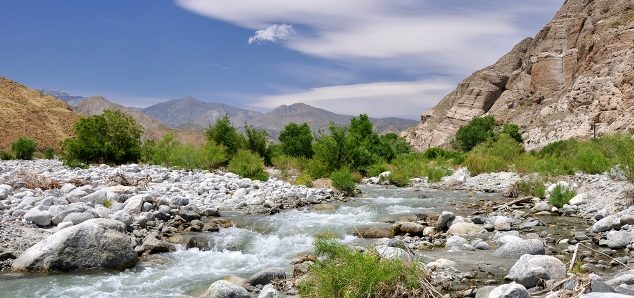Opinion
Ending the drought — in water data
 Rushing water flows through Whitewater Canyon in the Southern California desert. (Photo: Steve Minkler, via Shutterstock)
Rushing water flows through Whitewater Canyon in the Southern California desert. (Photo: Steve Minkler, via Shutterstock)California’s recent drought may have officially ended, but the state’s water data drought remains in full effect.
Shockingly, we don’t always know the answers to basic questions such as how much water is available in our state, let alone where and when. That’s why improving California’s woefully deficient stream gage network should be a top priority for the state.
Effective streamflow monitoring is the first step in understanding where water is and where it can and should go.
Effective water management often relies on streamflow data. This fundamental information helps farmers decide which crops to grow and cities plan future drinking water supplies. It helps identify and track flows needed for healthier ecosystems and warn communities about flood risks. It helps us know when we can use high flows to recharge groundwater supplies, and helps ensure that water is used in accordance with the law.
Unfortunately, when data are lacking or uncertain, we must rely on educated guesses about water supplies.
The result is myriad risks for activities that depend on water (and yes, ultimately that’s almost everything). Given the pressures to wisely use every drop of California’s water to meet multiple human and environmental objectives, we need timely and accurate management. And that requires timely and accurate measurement.
Effective streamflow monitoring is the first step in understanding where water is and where it can and should go.
Monitoring devices, such as stream gages, measure the most important vital sign of our waterways – the amount of water flowing in our rivers and streams. A single monitoring device gives information about a particular point on a stream. While helpful, data from one device can only tell us so much. A network of them is powerful and much more valuable, enabling data from multiple points to collectively paint a clearer and more nuanced picture of water supply for an entire river or watershed.
The state can and should enable innovation and entrepreneurship around monitoring.
California has over 176,000 stream miles, but its current stream gage network is dismally insufficient.
The Nature Conservancy estimates that only 14% of California’s streams have gages that allow managers to calculate the amount and timing of stream flows. And the problem worsens every year, as existing gages are taken out of commission due to lack of funding. The result? Nearly half of California’s 3,628 gages are inactive. While we’re not exactly flying blind, operating in a data-poor environment is akin to driving with gauze pulled over our eyes.
The good news is the fix for this problem is relatively straightforward. As we and our colleagues outlined in a recent UC Water issue brief, the state can take three key steps. First, it can identify what streamflow data are most needed to improve management decisions. Second, the state can assess its current network and decide what changes would most cost-effectively address those needs. Third, the state can create a long-term, scientifically valid plan for building its streamflow monitoring system into a coherent network. Funding for both new monitoring infrastructure and ensuring reliable, long-term support, will be crucial, since the value of monitoring networks increases dramatically with consistency and longevity.
This isn’t just about stream gages; innovation can also play a role in solving the problem. While stream gages are the most common and readily available way to measure streamflow, scientists are experimenting with a range of techniques. These novel approaches could include remote sensing, networked cameras, and drone-based technologies. The state can and should enable innovation and entrepreneurship around monitoring. It can do so by investing in technology development, and by focusing on outcomes and standards rooted in management needs, all informed by input from technical experts.
California has momentum in other areas of water data, and a governor who deeply understands the value of data. The state can become a national leader in water data while unlocking the potential to more effectively manage our water for the benefit of all Californians. Let’s push California’s streamflow monitoring into a future of clarity and accuracy, instead of letting it slowly dissipate into a cloud of uncertainty.
—
Editor’s Note: Kathleen Miller is a Water Law & Policy Research Fellow at the Center for Law, Energy, & the Environment (CLEE), UC Berkeley School of Law. Michael Kiparsky, Ph.D., directs the Wheeler Water Institute at CLEE. Graham Fogg, Nell Green Nylen, Holly Doremus, Andrew Fisher, Dave Owen, Samuel Sandoval Solis, and Joshua Viers contributed to this article as members of a UC Water research group focusing on streamflow monitoring.
Want to see more stories like this? Sign up for The Roundup, the free daily newsletter about California politics from the editors of Capitol Weekly. Stay up to date on the news you need to know.
Sign up below, then look for a confirmation email in your inbox.

Leave a Reply